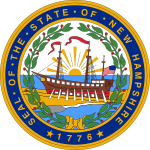
The 1956 United States presidential election was the 43rd quadrennial presidential election. It was held on Tuesday, November 6, 1956. President Dwight D. Eisenhower successfully ran for reelection against Adlai Stevenson II, the former Illinois governor whom he had defeated four years earlier. This election was the sixth rematch in American presidential history, something which did not occur again until 2024. It was the second time in which the winner was the same both times, the first being William McKinley's victories over William Jennings Bryan in 1896 and 1900. This was the last election before the term limits established by the 22nd Amendment, which applied to Eisenhower, came into effect.

The New Hampshire presidential primary is the first in a series of nationwide party primary elections and the second party contest, the first being the Iowa caucuses, held in the United States every four years as part of the process of choosing the delegates to the Democratic and Republican national conventions which choose the party nominees for the presidential elections to be held in November. Although only a few delegates are chosen in the New Hampshire primary, its real importance comes from the massive media coverage it receives, along with the first caucus in Iowa.

The Draft Eisenhower movement was a widespread political movement that eventually persuaded Dwight D. Eisenhower, former Chief of Staff of the United States Army, to contest the presidency of the United States.
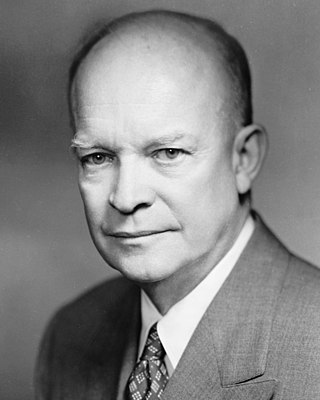
From March 11 to June 3, 1952, delegates were elected to the 1952 Republican National Convention.

From March 10 to June 2, 1964, voters of the Republican Party elected 1,308 delegates to the 1964 Republican National Convention through a series of delegate selection primaries and caucuses, for the purpose of determining the party's nominee for president in the 1964 United States presidential election.
Richard Nixon served as the 37th president of the United States from 1969 to 1974. He previously served as the 36th vice president of the United States from 1953 to 1961, and as a United States senator from 1950 to 1953 and United States representative from 1947 to 1950.

The 1960 United States presidential election in New York took place on November 8, 1960. All 50 states were part of the 1960 United States presidential election. Voters chose 45 electors to the Electoral College, which selected the president and vice president.

The 1956 United States presidential election in New York took place on November 6, 1956. All contemporary 48 states were part of the 1956 United States presidential election. Voters chose 45 electors to the Electoral College, which selected the president and vice president.

The 1956 United States presidential election in Massachusetts took place on November 6, 1956, as part of the 1956 United States presidential election, which was held throughout all contemporary 48 states. Voters chose 16 representatives, or electors to the Electoral College, who voted for president and vice president.

The 1960 United States presidential election in New Hampshire took place on November 8, 1960, as part of the 1960 United States presidential election, which was held throughout all 50 states. Voters chose four representatives, or electors to the Electoral College, who voted for president and vice president.
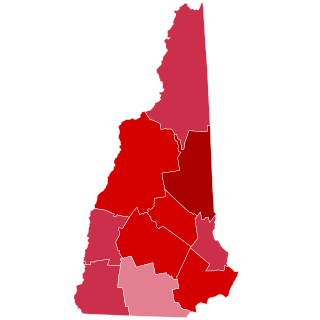
The 1956 United States presidential election in New Hampshire took place on November 6, 1956, as part of the 1956 United States presidential election, which was held throughout all contemporary 48 states. Voters chose four representatives, or electors to the Electoral College, who voted for president and vice president.

The 1952 United States presidential election in New Hampshire took place on November 4, 1952, as part of the 1952 United States presidential election, which was held throughout all contemporary 48 states. Voters chose four representatives, or electors to the Electoral College, who voted for president and vice president.
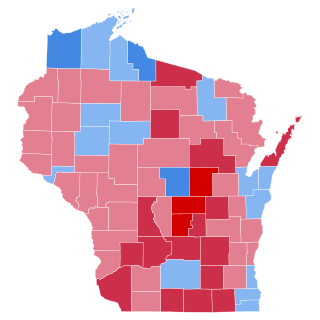
The 1960 United States presidential election in Wisconsin was held on November 8, 1960 as part of the 1960 United States presidential election. State voters chose 12 electors to the Electoral College, who voted for president and vice president. Politics in Wisconsin since the Populist movement had been dominated by the Republican Party. The Democratic Party became uncompetitive away from the Lake Michigan coast as the upper classes, along with the majority of workers who followed them, fled from William Jennings Bryan’s agrarian and free silver sympathies. Although the state did develop a strong Socialist Party to provide opposition to the GOP, Wisconsin developed the direct Republican primary in 1903 and this ultimately created competition between the “League” under Robert M. La Follette, and the conservative “Regular” faction. This ultimately would develop into the Wisconsin Progressive Party in the late 1930s, which was opposed to the conservative German Democrats and to the national Republican Party, and allied with Franklin D. Roosevelt at the federal level.

The 1956 United States presidential election in West Virginia took place on November 6, 1956, as part of the 1956 United States presidential election. West Virginia voters chose eight representatives, or electors, to the Electoral College, who voted for president and vice president.

The 1956 United States presidential election in Illinois took place on November 6, 1956, as part of the 1956 United States presidential election. State voters chose 27 representatives, or electors, to the Electoral College, who voted for president and vice president.

The 1956 United States presidential election in Maryland took place on November 6, 1956, as part of the 1956 United States presidential election. State voters chose nine representatives, or electors, to the Electoral College, who voted for president and vice president.

The 1972 New Hampshire Republican presidential primary was held on March 7, 1972, in New Hampshire as one of the Republican Party's statewide nomination contests ahead of the 1972 United States presidential election. Incumbent President Richard Nixon faced his first major test in New Hampshire against two minor challengers: liberal anti-Vietnam war candidate Pete McCloskey of California and conservative John Ashbrook of Ohio, who opposed Nixon's détente policies towards China and the Soviet Union. Nixon won the Granite State in a landslide, resulting in the withdrawal of McCloskey from the primaries and a clear path for the incumbent President to receive the Republican nomination.

The 1968 New Hampshire Republican presidential primary was held on March 12, 1968, in New Hampshire as one of the Republican Party's statewide nomination contests ahead of the 1968 United States presidential election. While the nomination itself was contested, former Vice President Richard Nixon ran virtually unopposed in the Granite State, thus winning in a landslide. He defeated his nearest opponent, Nelson Rockefeller, by 67 percentage points. Nixon would go on to win the GOP nomination, and the presidency.
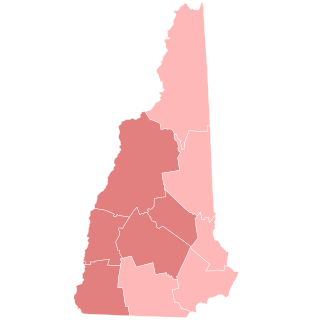
The 1952 New Hampshire Republican presidential primary was held on March 11, 1952, in New Hampshire as one of the Republican Party's statewide nomination contests ahead of the 1952 United States presidential election. General Dwight D. Eisenhower defeated Senator Robert Taft of Ohio by 12 percentage points on his way to eventual nomination by the Republican Party for President and victory in the 1952 election against Democrat Adlai Stevenson. This was the first time that voters participating in the New Hampshire primary could vote directly for candidates, rather than for delegates to the Republican National Convention.


